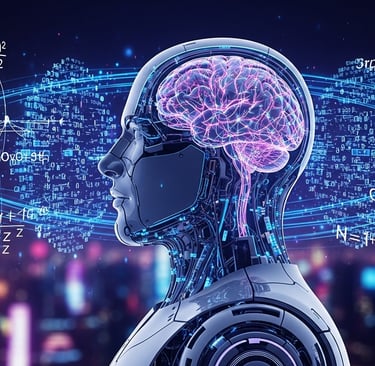Physics and AI: The Untold Relation
The relationship between physics and artificial intelligence runs deeper than most realize. While AI is often viewed as a purely computational field, its foundations are inextricably linked to physical principles, and its future may well depend on our understanding of the universe's most fundamental laws.
TECHNOLOGYARTIFICIAL INTELLIGENCEPHYSICS
Hitanshu Soni
7/5/20256 min read


The Mathematical Foundation
Physics and AI share a common mathematical language, like two people speaking the same dialect. The same math equations that describe how particles move in space also help AI systems learn from data. Think of it this way: when Netflix recommends movies you might like, it's using mathematical patterns similar to those physicists use to predict how planets orbit the sun. Both are looking for hidden patterns and making predictions based on past behaviour.
This isn't a coincidence—it's evidence of a deeper connection. Both fields seek to understand complex systems, whether those systems are galaxies, atoms, or artificial minds trying to recognise your face in a photo.
Energy and Computation
Perhaps nowhere is the physics-AI connection more apparent than in energy consumption. Every time your phone recognises your voice or your car's GPS calculates the fastest route, it's burning energy, and AI systems are particularly hungry consumers.
Here's a real-world example: Training ChatGPT required as much electricity as 1,000 American homes use in a year. Google's AI systems consume enough power to run a small city. This isn't just about bigger electricity bills—it's about the fundamental physics of computation.
There's actually a law of physics called Landauer's principle that says every time a computer "forgets" information, it must release heat. This means there are physical limits to how efficient computers can be, just like there are limits to how fast a car can go without breaking the laws of physics.
Quantum Mechanics and Machine Learning
Quantum mechanics sounds like science fiction, but it's already changing AI in practical ways. Regular computers process information like a light switch—either on or off. Quantum computers are like magic light switches that can be on, off, and both at the same time.
Google's quantum computer completed a calculation in 200 seconds that would take the world's fastest regular computer 10,000 years. While we're still in the early days, quantum AI could eventually help us discover new medicines, predict the weather more accurately, and solve traffic problems in real time.
But here's the fascinating part: AI is also helping physicists understand quantum mechanics. At CERN, the world's largest particle physics laboratory, AI systems analyse collision data to discover new particles. It's like having a super-powered microscope that can spot patterns human scientists would miss.
The Physics of Intelligence
Your brain is basically a biological computer that runs on about 20 watts of power, roughly the same as a dim light bulb. Yet it can recognise faces, understand language, and create art. Understanding how this biological computer works helps us build better artificial ones.
Scientists have discovered that the brain operates at a "sweet spot" between order and chaos. Think of it like a jazz musician—too much structure and there's no creativity, too little and it's just noise. The brain balances on this edge, allowing it to be both stable and flexible.
This discovery is now helping AI researchers design better systems. DeepMind's AlphaGo, which beat the world champion at the ancient game of Go, uses similar principles. It balances exploring new moves with exploiting what it already knows works, just like how your brain balances routine with creativity.
Real-World Examples of Physics-AI Fusion
Weather Prediction: The European Centre for Medium-Range Weather Forecasts now uses AI that understands fluid dynamics (how air and water move) to predict weather 10 days ahead with 90% accuracy. It's like having a crystal ball that actually works because it follows physics laws.
Drug Discovery: AI systems are helping pharmaceutical companies design new medicines by understanding how molecules behave according to quantum mechanics. What used to take 10-15 years might now take 3-5 years, potentially saving millions of lives.
Space Exploration: NASA's Perseverance rover on Mars uses AI to navigate the planet's surface by understanding the physics of how wheels interact with different types of terrain. It's like having an autonomous car that works 140 million miles away from Earth.
Medical Imaging: MRI machines create images using powerful magnets and radio waves. AI now helps doctors interpret these images by understanding the physics of how different tissues respond to magnetic fields. This helps detect cancer and other diseases earlier than ever before.
The Inverse Problem: AI as a Detective
Much of physics involves being a detective: given the evidence, figure out what happened. This is exactly what AI excels at.
Take the famous black hole image from 2019. Scientists didn't actually "see" the black hole directly—they collected radio wave data from telescopes around the world and used AI to piece together what the black hole must look like. It's like reconstructing a crime scene from scattered clues.
Another example: protein folding. Google's AlphaFold AI can predict how proteins fold into their final shapes by understanding the physics of how atoms attract and repel each other. This solved a 50-year-old problem in biology and could revolutionize medicine.
Simple Examples You Experience Daily
Your Smartphone Camera: When you take a photo and it automatically adjusts brightness and sharpness, it's using AI that understands the physics of light. The camera knows how light behaves when it bounces off different surfaces and adjusts accordingly.
Voice Assistants: When Siri or Alexa understands your voice, they're using AI that understands the physics of sound waves. They know how sound travels through air and how your vocal cords create different frequencies.
GPS Navigation: Your phone's GPS uses AI that understands Einstein's theory of relativity. GPS satellites experience time slightly differently than we do on Earth due to gravity, and the system must account for this physics principle to give you accurate directions.
Auto-Focus in Cameras: The autofocus feature uses AI that understands optics—the physics of how lenses bend light to create sharp images. It's like having a tiny physicist inside your camera making split-second calculations.
Future Convergence: What's Coming Next
The future holds exciting possibilities that sound like science fiction but are grounded in real physics:
Brain-Computer Interfaces: Companies like Neuralink are developing chips that could connect directly to your brain, using AI that understands the electrical signals of neurons. Imagine controlling your computer just by thinking.
Optical AI Computers: Instead of electrical signals, future AI might use light beams to process information. Light travels much faster than electrical signals, potentially making AI systems thousands of times faster.
Room-Temperature Quantum Computers: Current quantum computers need to be kept colder than outer space to work. But physicists are working on quantum systems that work at room temperature, which could put quantum AI in your pocket.
AI-Designed Materials: AI systems are already helping discover new materials with properties that seem impossible—like metals that are lighter than water or materials that conduct electricity with zero resistance.
The Philosophical Dimension
Perhaps most profoundly, both physics and AI grapple with questions of emergence and consciousness. How does intelligence arise from simple components? What is the relationship between information and physical reality? These questions sit at the intersection of physics, AI, and philosophy.
As we develop artificial general intelligence, we're not just creating new technology—we're exploring the fundamental nature of intelligence itself. Physics provides the foundation, the constraints, and the inspiration for this journey.
Conclusion
The relationship between physics and AI isn't just academic—it's the foundation of the technology revolution happening around us. Every time you use your smartphone, get directions, or stream a video, you're experiencing the marriage of physics and artificial intelligence.
Understanding this connection helps us appreciate both the incredible capabilities and the fundamental limits of AI. Just as cars can't exceed the speed of light, AI systems must operate within the laws of physics. But within those laws, the possibilities are boundless.
As we stand on the brink of even more advanced AI, the physics connection becomes crucial. The future of AI isn't just about better algorithms or more data—it's about understanding the physical principles that govern intelligence itself, from the quantum realm to the cosmic scale.
The story of physics and AI is still being written, and it may be the most important story of our time. We're not just building smarter machines—we're unlocking the secrets of intelligence itself.


Hitanshu Soni
Software Developer Engineer at SportVot
